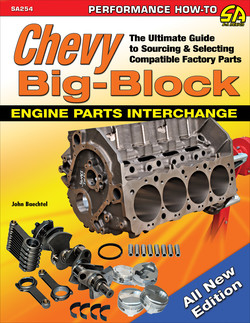Читать книгу Chevy Big-Block Engine Parts Interchange - John Baechtel - Страница 6
На сайте Литреса книга снята с продажи.
ОглавлениеINTRODUCTION
Big-block Chevys are among the most prolific and widely used racing and high-performance engines in the world next to the renowned Chevy small-block. The small-block Chevy was already nicknamed the “mouse motor,” so it was only logical that its bigger brother was ultimately christened the “rat motor.” Some insist that rat motors are equally significant and they’ll find no argument here. Few would dare to question the legendary big-block’s position in the hierarchy of high-performance engines. In many cases they dominate classes in which small-blocks are incapable of providing the brute torque and horsepower required. While competing brands also manufactured historically significant big-block engines, none except the Chrysler Hemi has maintained the longevity and sterling performance record established by Chevrolet big-block V-8s. Indeed the Hemi is the only other original legendary engine package still available (albeit in crate engine form only), but not to the extraordinary degree of production use established by Chevrolet’s brutally powerful big-blocks.
The 350-hp L34 396 (1966–1969) was a strong player with a forged-steel crank, high-lift hydraulic camshaft, Holley 4-barrel (1966–1968), and 25 hp more than the standard 325-hp L35 version used in Camaros, Novas, and full-size cars through 1972. (Photo Courtesy Tom Dufur)
Chevrolet big-blocks still power Chevrolet trucks nearly 50 years after their debut. The last Gen I Hemi-powered production vehicle went off the market in the mid-1970s. Meanwhile Mark IV Chevy big-blocks are still going strong. They were designed to be bigger, tougher, and more powerful. Canted-valve free-breathing “porcupine” heads are their primary performance feature, but they were also built with strength, durability, and high-performance in mind. To this end they incorporated thicker cylinder walls, bigger mains, forged cranks and rods, forged pistons, big valves, solid lifter cams, and aluminum intake manifolds; it’s a proven recipe for building high-performance large-displacement big-blocks that mean business.
This ground-pounding Reher-Morrison big-block raised the world wheel-driven piston-powered land speed record to more than 414 mph with carburetors and nitrous oxide injection.
Mark IV big-blocks were first delivered in 396- and 427-ci versions. With Mark II–based canted-valve heads the name “porcupine” head was coined early, but eventually faded; the engines simply became known as big-blocks or rat motors. (Photo Courtesy GM Media Archive)
The 360-hp LS5 454 came in Monte Carlos and Chevelles with a steel crank, hydraulic cam, high-lift hydraulic camshaft, dual exhaust, cast-iron oval-port heads, and two- or four-bolt mains. The same engine was rated at 390 hp in Corvettes. (Photo Courtesy Tom Dufur)
Big-blocks have evolved into the ultimate form of doorslammer drag racing with the DRCE (Drag Race Competition Engine) that continues to dominate Pro Stock racing. No interchangeable parts here, but solid big-block heritage nonetheless. (Photo Courtesy JEGS)
Big-block Chevys remain the predominant power plant in Pro Stock and Pro Mod drag racing, but have never seriously challenged the Chrysler Hemi in the higher fuel and alcohol classes. By the time the big-block came about, racers had already embraced the Hemi in these classes. A few big-blocks were run in the Top Fuel and Funny Car ranks, but early teething problems caused racers to abandon them in favor of tried-and-true Hemi power plants that were already well developed for the unique stresses of the fuel racing environment.
Nonetheless the big-block has dominated sportsman drag racing classes nearly as much as the small-block Chevy and it is pretty much the default performance engine choice for general marine applications including drag boat and offshore powerboat racing. The big-block was groomed as “the” performance engine for the legions of loyal followers who would rather race than watch; hence Chevrolet never entertained the possibility of its use in fuel racing.
Big-blocks are dominant in tractor pulling and they have been used in aviation applications and road racing; they are used much less frequently in off-road competition. It is one of the primary choices for bracket and sportsman drag racing and is second only to the small-block for most high-performance street applications. The amazing proliferation of the Chevy big-block reinforces the integrity of the design philosophy and in some respects the historical relevance of its esteemed predecessor, the legendary Mark I big-block 409.
